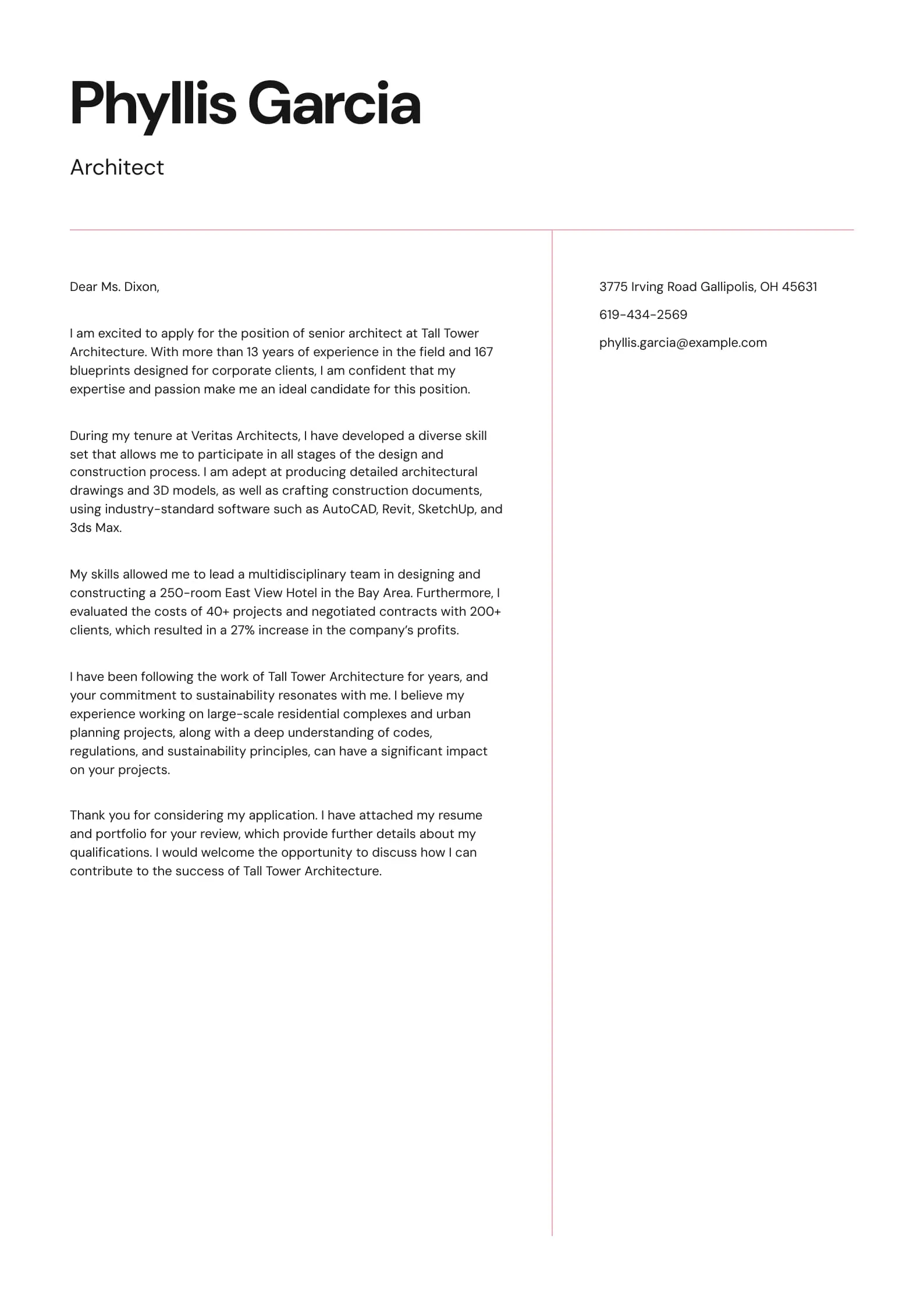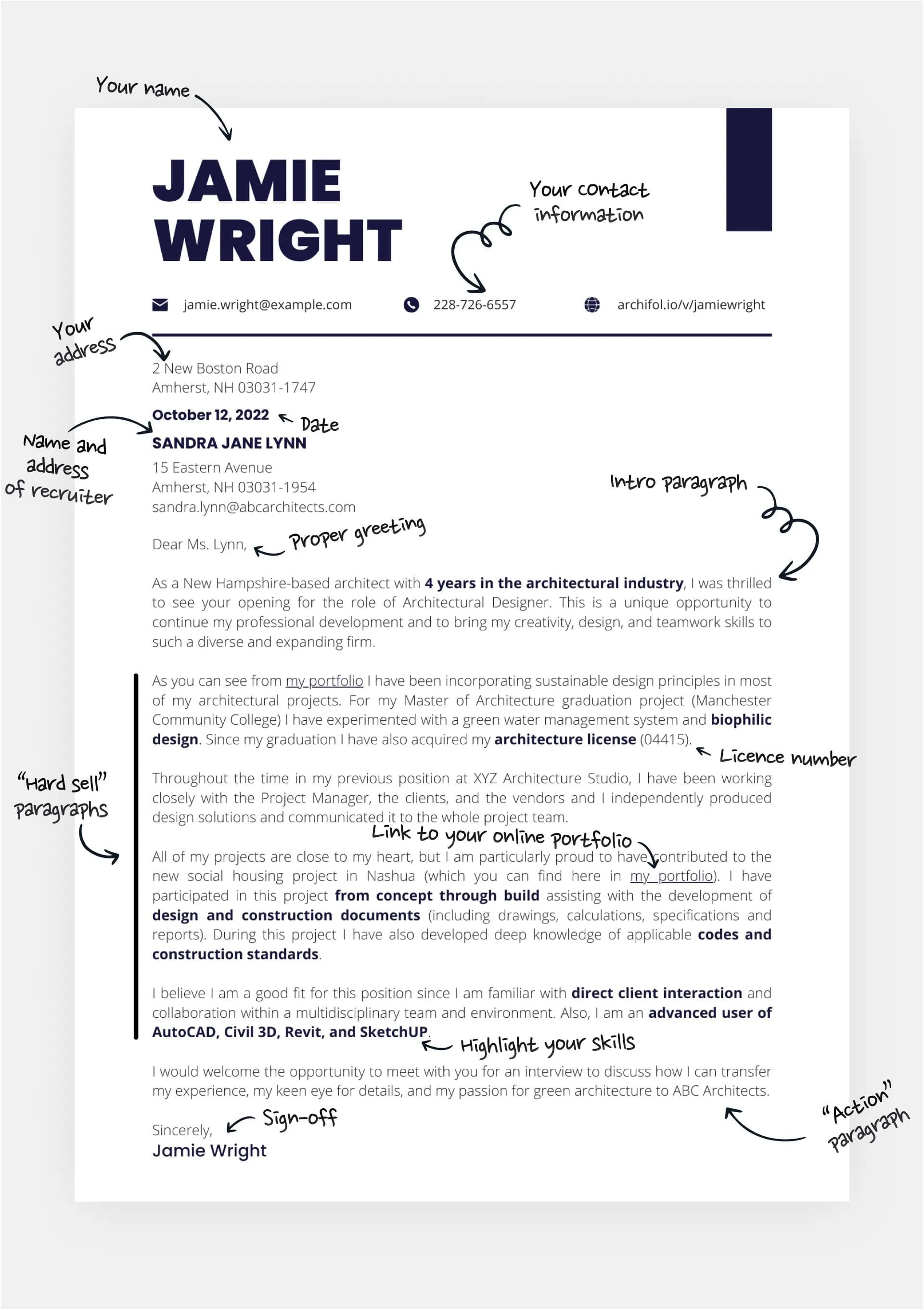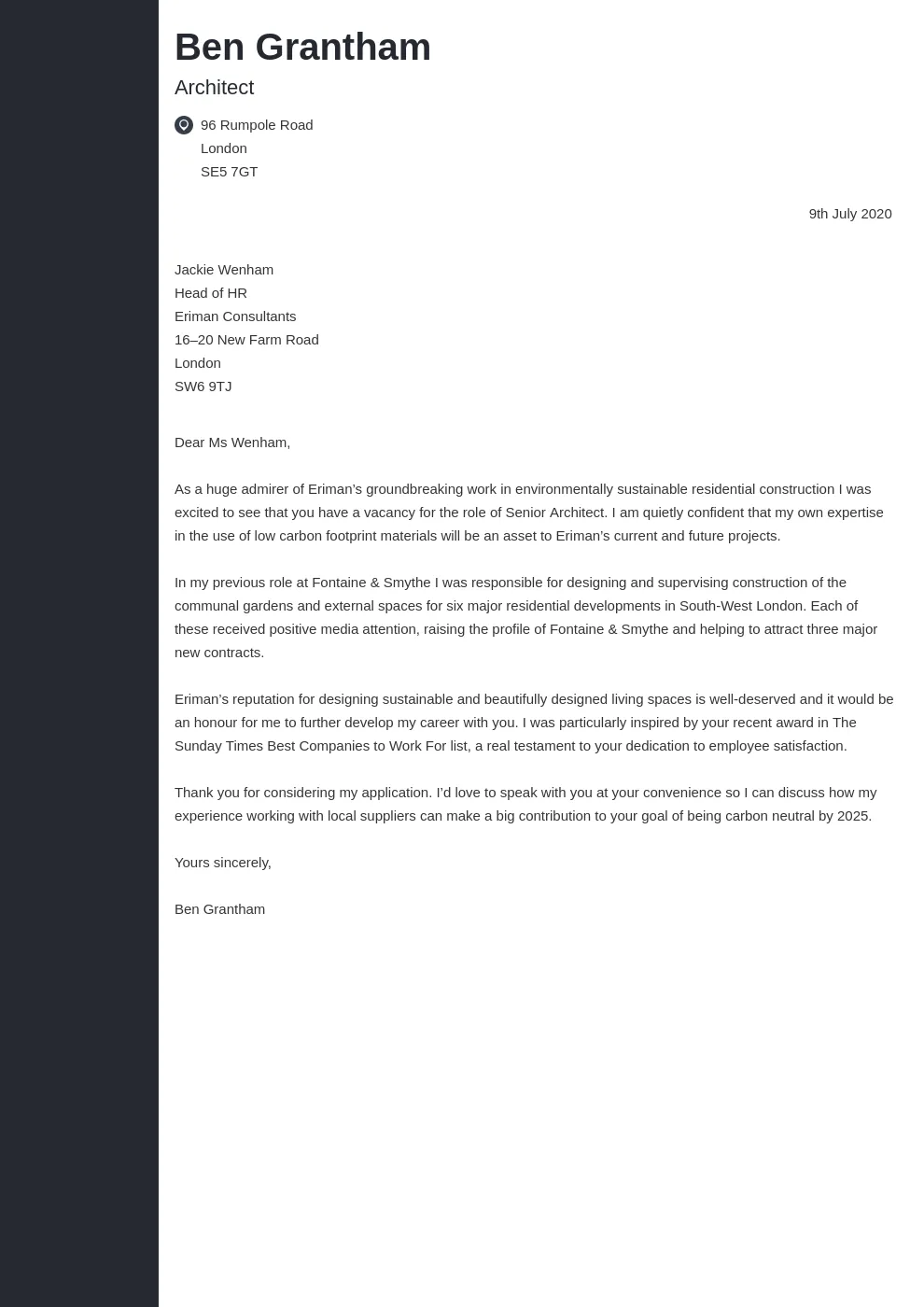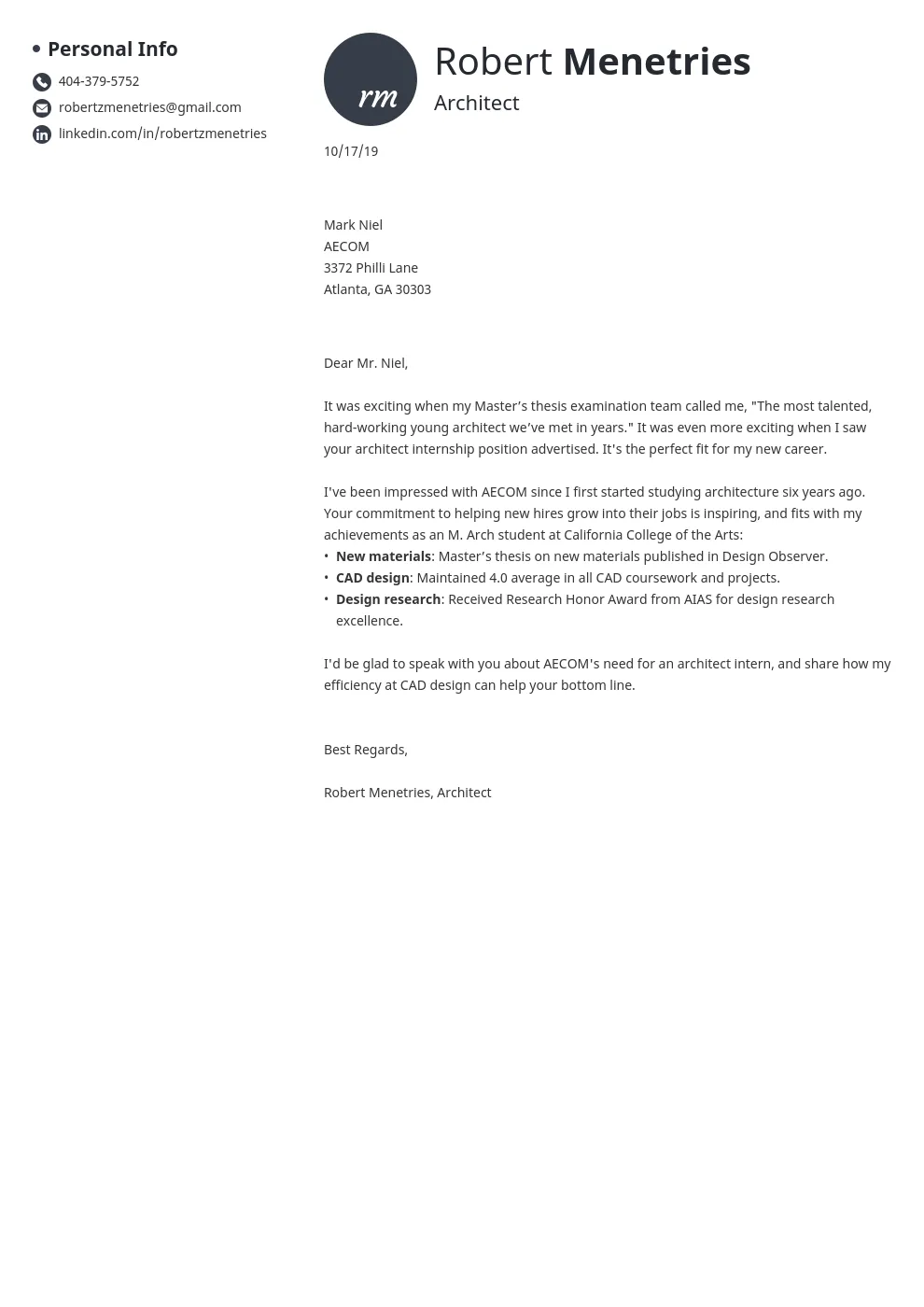Mastering the Architect Cover Letter
A well-crafted cover letter is your first opportunity to make a compelling impression on potential employers in the architecture field. It’s your chance to go beyond the bullet points of your resume and showcase your personality, passion for architecture, and specific qualifications that align with the job requirements. To create a standout cover letter, focus on demonstrating your understanding of the firm, highlighting your relevant skills and experiences, and expressing your enthusiasm for the position. This introduction should establish the context, set the stage for why you’re applying, and indicate your understanding of the architecture company’s work. A cover letter that is targeted to a specific job is a must; a generic letter won’t get you noticed. A cover letter is more than just a formality; it’s a powerful tool that can significantly enhance your job application.
Highlighting Your Architecture Skills
Your cover letter should clearly articulate your key architectural skills, emphasizing those most relevant to the specific role. Begin by identifying the core competencies sought by the firm, and then provide specific examples of how you’ve demonstrated these skills in previous projects. This might include design capabilities, technical proficiency, project management expertise, and your ability to collaborate effectively with teams. When listing skills, be specific rather than general. For instance, instead of simply stating ‘proficient in design,’ mention ‘skilled in conceptual design, space planning, and developing detailed architectural drawings using AutoCAD and Revit.’ By focusing on how you’ve applied these skills in real-world scenarios, you’ll provide concrete evidence of your capabilities. Tailor your skill set to match the job description. If the role emphasizes sustainable design, highlight your experience with green building practices, materials, and relevant certifications. This personalized approach makes your application more impactful.
Showcasing Design Proficiency

Architectural design proficiency is a fundamental aspect of an architect’s role, so your cover letter must demonstrate this with vivid examples. The best way to showcase your design skills is by mentioning specific projects where you’ve been involved and the unique design challenges you overcame. Describe your role in the design process, from initial concepts and sketches to detailed plans and 3D renderings. Mention the design principles and aesthetic elements you utilized, and explain how your design decisions met the project goals, such as functionality, sustainability, or client preferences. Visual elements can enhance your application. While you can’t include images in your cover letter, refer to your portfolio and make sure it’s easy to access. Your cover letter should guide the reader to view your best work, and provide details that create a cohesive presentation of your skills. Showcasing a diverse range of projects can also underscore your versatility.
Detailing Project Experience
Your cover letter should highlight your relevant project experiences, providing specific details that showcase your ability to manage projects effectively. For each project, describe your role and responsibilities, outlining the scope of work, key milestones, and your specific contributions. Give examples of how you handled challenges, collaborated with teams, and ensured the successful completion of projects. Be sure to include specifics, such as the type of project (residential, commercial, institutional), the project size, and any unique aspects of the project. If you worked on large, complex projects, emphasize your experience coordinating with other professionals, such as engineers, contractors, and consultants. Quantifying the impact of your work is also useful. For instance, instead of just saying you ‘managed projects,’ you might state that you ‘managed projects with budgets up to $X, resulting in a Y% reduction in costs.’ This approach provides concrete evidence of your capabilities and adds credibility to your application.
Quantifying Accomplishments
To make your cover letter as impactful as possible, quantify your accomplishments whenever possible. Instead of vague statements, use specific numbers, percentages, and metrics to illustrate your achievements and the value you brought to previous projects. For instance, rather than saying you ‘improved project efficiency,’ state that you ‘reduced project timelines by 15% through efficient project management strategies.’ If you have been involved in projects that were recognized with awards or accolades, be sure to include these details. This tangible evidence will demonstrate the impact of your work and set you apart from other candidates. Quantifiable achievements are a powerful way to demonstrate your ability to make a real difference. Consider using data to highlight how your designs saved costs, improved sustainability, or enhanced client satisfaction. By focusing on measurable results, you provide concrete evidence of your value and increase your chances of securing the job.
Demonstrating Software Expertise

In the field of architecture, proficiency in various software programs is crucial, and your cover letter should clearly list your software skills. Be specific about the programs you know, mentioning both the specific software titles and your level of expertise (e.g., proficient, intermediate, beginner). Common software to include are AutoCAD, Revit, SketchUp, 3ds Max, and other design and modeling tools. If you have experience with specific building information modeling (BIM) software, be sure to highlight this, as it is increasingly important in the industry. Go beyond simply listing the software and provide context. For example, if you used Revit to design a complex project, briefly explain the project and how you used the software to overcome challenges and achieve design goals. Demonstrating your software skills effectively assures employers that you can seamlessly integrate into their workflow, and it significantly increases your appeal as a candidate.
Tailoring to the Architecture Firm
One of the most critical steps in writing a compelling cover letter is tailoring it to the specific architecture firm you are applying to. This shows you’ve done your research and are genuinely interested in working there. Begin by thoroughly researching the firm. Understand their mission, design style, and types of projects they specialize in. Examine their website, portfolio, and social media presence. Look for recent projects, awards, and any information that highlights their culture and values. Address the letter to the hiring manager or a specific person, if possible. This shows you’ve taken the time to go the extra mile. Demonstrate how your skills and experience align with the firm’s values and project types. If they emphasize sustainability, highlight your relevant experience. If they’re known for innovative designs, showcase similar projects in your portfolio. By demonstrating a clear understanding of the firm, you prove you’re a good fit and that you are serious about the opportunity.
Formatting Your Cover Letter
The format of your cover letter is an important factor in making a good first impression. Keep the letter concise and professional, typically fitting on a single page. Use a clear and readable font, such as Arial or Times New Roman, with a font size of 11 or 12 points. Make sure the text is well-spaced and easy on the eyes. Use headings and bullet points to break up text and make the letter more readable. Always begin with your contact information, followed by the date, the hiring manager’s name (if known), and the firm’s address. Write a compelling opening paragraph that immediately grabs the reader’s attention, and finish with a strong closing statement. Be sure to proofread carefully. Ensure there are no typos or grammatical errors. Proofreading is essential because any errors can create a negative impression, undermining all of the effort you put into crafting the perfect letter. Proofread multiple times and even ask a friend to review the letter for you.
Reviewing and Proofreading

Before submitting your cover letter, always review and proofread it thoroughly. Errors in spelling, grammar, or formatting can make your cover letter look unprofessional. Proofreading multiple times is critical to catch any mistakes. Read the letter aloud to catch any awkward phrasing. Use spell-check, but don’t rely on it entirely, as it may miss contextual errors. Ensure the tone of the cover letter is consistent and professional throughout. Make sure all of your information is up to date and accurate. Check the firm’s website and job posting one last time to ensure you’ve accurately reflected their requirements and preferences. Consider asking a trusted friend or mentor to review your letter as well. They can often spot errors or suggest improvements you might have missed. This final review is crucial for presenting a polished and professional cover letter, thereby increasing your chances of making a great impression.
Making a Strong Impression
A well-written cover letter is an essential part of your job application process. By following these tips, you can create a cover letter that effectively showcases your skills, experiences, and passion for architecture. Remember to tailor your cover letter to each specific job and firm. Highlight the skills and experiences that are most relevant to the position, and quantify your accomplishments whenever possible. Your cover letter is your chance to set yourself apart from other candidates, so take the time to craft a compelling, professional document that highlights your unique qualifications and abilities. Demonstrate enthusiasm, and show that you understand the firm’s mission and values. By following these steps, you’ll be well on your way to making a strong impression and securing your dream job. Good luck with your job search!
